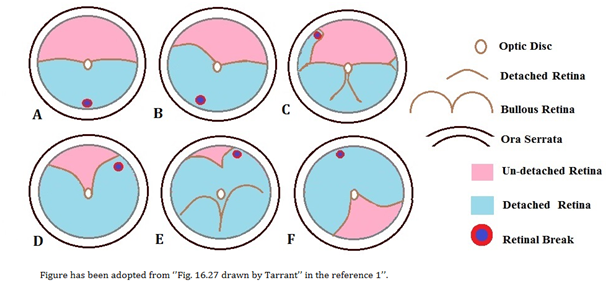Advances in
eISSN: 2377-4290


Editorial Volume 8 Issue 5
Onsekiz Mart University, Faculty of Medicine, Department of Ophthalmology, Çanakkale, Turkey
Correspondence: Burak Turgut, MD, Onsekiz Mart University, Faculty of Medicine, Department of Ophthalmology, Çanakkale, Turkey, Tel +90 533 7128389
Received: January 01, 1971 | Published: October 4, 2018
Citation: Turgut B. Remembering the Modified Lincoff ’s rules for practical identification of retinal break in regmatogenous retinal detachment. Adv Ophthalmol Vis Syst. 2018;8(5):267 ? 268. DOI: 10.15406/aovs.2018.08.00318
modified Lincoff’s rules, retinal break, sub retinal fluid, detachment
RB, retinal break; RRD, regmatogen retinal detachment; VRS, vitreoretinal surgery; PPV, pars plana vasectomy; SRF, sub retinal fluid; PVD, posterior vitreous detachment; OD, optic disc
Finding retinal break (RB) causing rhegmatogenous retinal detachment (RRD) is a critical step before vitreoretinal surgery (VRS). To locate and find small-dimensioned or hidden RBs in thin, folded and clear retina may sometimes be difficult. Intraoperative visualization of the peripheral retina in pars plana vitrectomy (PPV) may provide to detect these. However, each RB cannot be detected even during careful peripheral retinal examination with indentation. The detection of the RB is the first stage of the management of RRD. Possible localizations of RBs in the eyes with RRD are supero temporal (60%), superonasal (15%), inferotemporal (15%) and inferonasal (10%) quadrants. Additionally, it should not forget that there is more than one RB, and it is often within 90° of each other in about 50% of the eyes with RRD. RBs in pseudophakic eyes are almost invariably anterior to the equator.1 In most cases, RBs can be detected through Lincoff’s rules before the surgery. Although the application of these rules has been not used as much as in the past, I think that Lincoff’s rules should be taken into account again in the identification of the RBs. Modified Lincoff’s rules are rules to detection of primary RBs based on the configuration of sub retinal fluid (SRF) and the localisation of RRD in retrospective analysis of 1,000 cases of RD.1 In a recent study, it has been reported that anterior RBs and posterior vitreous detachment (PVD) have a significant association with validity of Lincoff rules.2 It has been reported that these rules are conformed to 96% of cases with primary RRD. Modified Lincoff’s rules include followings:1,3‒6

Figure 1 Highly possible retinal breaks for retinal detachments at various quadrants.
Note Figure has been adopted from ‘’Fig. 16.27 drawn by Tarrant’’ in the reference 1’’.
In conclusion, in this editorial, I aimed to remind modified Lincoff’s rules for identification of primary RBs in RRD.
None.
The author declares that there is no conflict of interest.
The author received no financial support for the research, authorship, and/or publication of this article.
Concept and design, literature search, analysis, interpretation: Burak TURGUT.

©2018 Turgut. This is an open access article distributed under the terms of the, which permits unrestricted use, distribution, and build upon your work non-commercially.